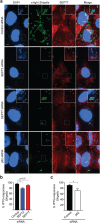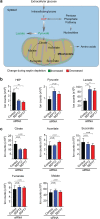A requirement for septins and the autophagy receptor p62 in the proliferation of intracellular Shigella
- PMID: 29752866
- PMCID: PMC6519264
- DOI: 10.1002/cm.21453
A requirement for septins and the autophagy receptor p62 in the proliferation of intracellular Shigella
Abstract
Shigella flexneri, a Gram-negative enteroinvasive pathogen, causes inflammatory destruction of the human intestinal epithelium. During infection of epithelial cells, Shigella escape from the phagosome to the cytosol, where they reroute host cell glycolysis to obtain nutrients for proliferation. Septins, a poorly understood component of the cytoskeleton, can entrap cytosolic Shigella targeted to autophagy in cage-like structures to restrict bacterial proliferation. Although bacterial entrapment by septin caging has been the subject of intense investigation, the role of septins and the autophagy machinery in the proliferation of noncaged Shigella is mostly unknown. Here, we found that intracellular Shigella fail to efficiently proliferate in SEPT2-, SEPT7-, or p62/SQSTM1-depleted cells. Consistent with a failure to proliferate, single cell analysis of bacteria not entrapped in septin cages showed that the number of metabolically active Shigella in septin- or p62-depleted cells is reduced. Targeted metabolomic analysis revealed that host cell glycolysis is dysregulated in septin-depleted cells, suggesting a key role for septins in modulation of glycolysis. Together, these results suggest that septins and the autophagy machinery may regulate metabolic pathways that promote the proliferation of intracellular Shigella not entrapped in septin cages.
Keywords: Shigella; autophagy; cytoskeleton; metabolism; septin.
© 2018 The Authors. Cytoskeleton Published by Wiley Periodicals, Inc.
Figures



References
-
- Araiza‐Olivera, D. , Chiquete‐Felix, N. , Rosas‐Lemus, M. , Sampedro, J. G. , Peña, A. , Mujica, A. , & Uribe‐Carvajal, S. (2013). A glycolytic metabolon in Saccharomyces cerevisiae is stabilized by F‐actin. FEBS Journal, 280(16), 3887–3905. - PubMed
Publication types
MeSH terms
Substances
Grants and funding
LinkOut - more resources
Full Text Sources
Other Literature Sources

